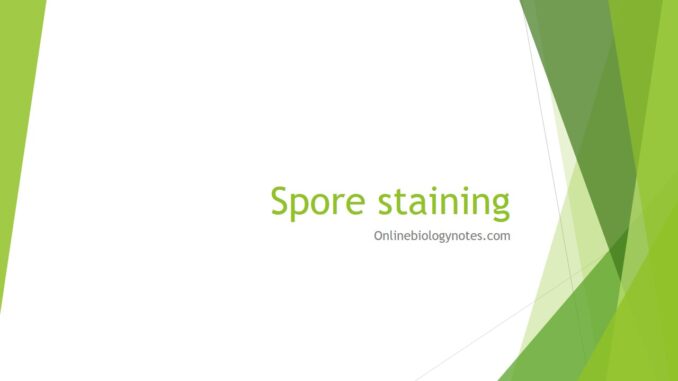
Principle:
- Members of the anaerobic genera Clostridium and Desulfotomaculum and the aerobic genus Bacillus are examples of organisms that have the capacity to exist either as metabolically active vegetative cells or as highly resistant, metabolically inactive cell types called spores. When environmental conditions become unfavorable for continuing vegetative cellular activities, particularly with the exhaustion of a nutritional carbon source, these cells have the capacity to undergo sporogenesis and give rise to a new intracellular structure called the endospore, which is surrounded by impervious layers called spore coats. As conditions continue to worsen, the endospore is released from the degenerating vegetative cell and becomes an independent cell called a free spore. Because of the chemical composition of spore layers, the spore is resistant to the damaging effects of excessive heat, freezing, radiation, desiccation, and chemical agents, as well as to the commonly employed microbiological stains. With the return of favorable environmental conditions, the free spore may revert to a metabolically active
and less resistant vegetative cell through germination. It should be emphasized that sporogenesis and germination are not means of reproduction but merely mechanisms that ensure cell survival under all environmental conditions.
In practice, the spore stain uses two different stains and decolorizing agents:
1. Primary Stain (Malachite Green):
- Unlike most vegetative cell types that stain by common procedures, the free spore, because of its impervious coats, will not accept the primary stain easily. For further penetration, the application of heat is required. After the primary stain is applied and the smear is heated, both the vegetative cell and spore will appear green.
2. Decolorizing Agent (Water):
- Once the spore accepts the malachite green, it cannot be decolorized by tap water, which removes only the excess primary stain. The spore remains green. On the other hand, the stain does not demonstrate a strong affinity for vegetative cell components; the water removes it, and these cells will be colorless.
3. Counter stain (Safranin):
- This contrasting red stain is used as the second reagent to color the decolorized vegetative cells, which will absorb the counterstain and appear red. The spores retain the green of the primary stain.
Requirements
- i). Bacterial Culture: 48-72 hrs nutrient agar slant culture of Bacillus cereus and thioglycollate culture of Clostridium sporogenes.
- ii. Reagents: Malachite green and safranin.
- iii. Equipment: Microincinerator or Bunsen burnerhot plate, staining tray, inoculating loop, glass slides, bibulous paper, lens paper, and microscope.
Procedure for Spore staining:
- Obtain two clean glass slides.
- Make individual smears in the usual manner using aseptic technique.
- Allow smear to air-dry, and heat fix in the usual manner.
- Flood smears with malachite green and place on top of a beaker of water sitting on a warm hot plate, allowing the preparation to steam for 2 to 3 minutes. Note: Do not allow stain to evaporate; replenish stain as needed. Prevent the stain from boiling by adjusting the hot
plate temperature. - Remove slides from hot plate, cool, and wash under running tap water.
- Counterstain with safranin for 30 seconds.
- Wash with tap water.
- Blot dry with bibulous paper and examine under oil immersion.
- In the chart provided in the Lab Report, complete the following:
- Draw a representative microscopic field of each preparation.
- Describe the location of the endospore within the vegetative cell as central, sub-terminal, or terminal on each preparation.
- Indicate the color of the spore and vegetative cell on each preparation

